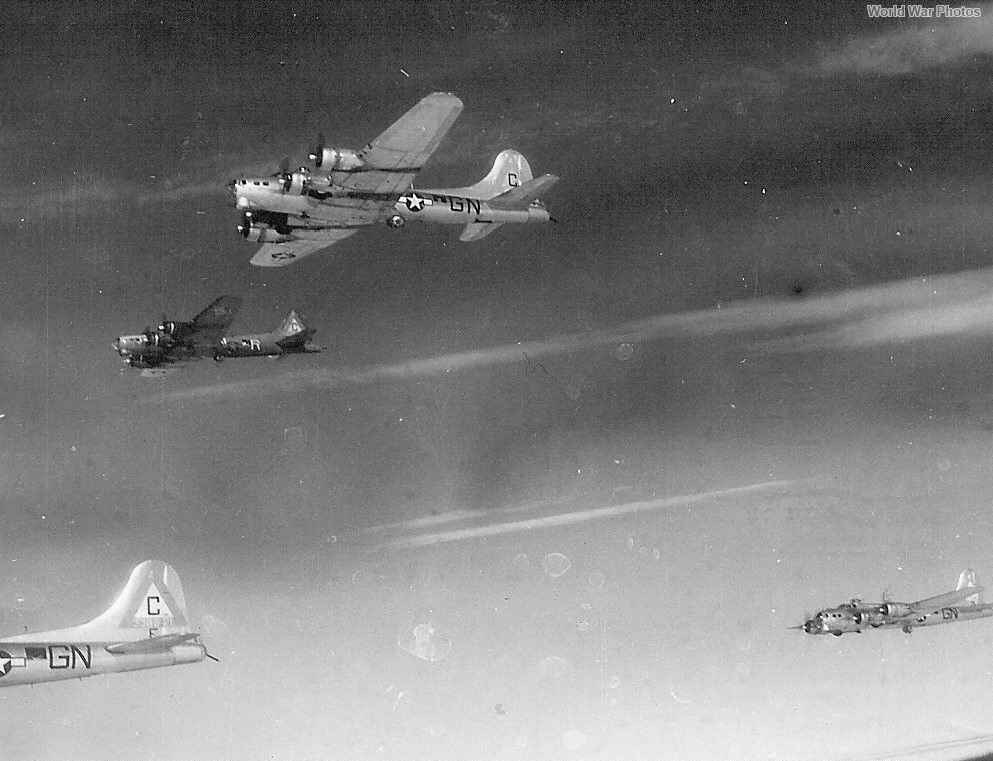The 303rd Bombardment Group (H), known as “Hell’s Angels”, was a highly distinguished B-17 Flying Fortress unit within the United States Army Air Forces during World War II. Below is an in-depth look at the unit’s operational details, structure, and aircraft markings:
Unit Overview:
- Assigned to Eighth Air Force: 10 September 1942.
- Primary Combat Aircraft: B-17F (from blocks 25-BO); B-17G.
- Station: Molesworth, UK (12 September 1942 – 11 June 1945).
Wing & Command Assignments:
- 10 September 1942: VIII Bomber Command (BC), 1st Bomb Wing (BW).
- February 1943: VIII BC, 1 BW, 102nd Provisional Combat Bomb Wing (PCBW).
- May 1943: VIII BC, 1 BW, 103rd PCBW.
- 13 September 1943: VIII BC, 1st Bomb Division (BD), 41st Combat Bomb Wing (CBW).
- 8 January 1944: 1 BD, 40th CBW.
- 1 January 1945: 1st Air Division (AD), 40th CBW.
Component Squadrons:
- 358th Bombardment Squadron (H)
- 359th Bombardment Squadron (H)
- 360th Bombardment Squadron (H)
- 427th Bombardment Squadron (H)
Group Commanding Officers:
- Col. James H. Wallace: 13 July 1942 – 12 February 1943.
- Col. Charles E. Marion: 13 February 1943 – 19 July 1943.
- Col. Kermit D. Stevens: 19 July 1943 – 1 September 1944.
- Col. William S. Raper: 29 October 1944 – 19 April 1945.
- Lt. Col. William C. Sipes: 19 April 1945 – 11 June 1945.
- (Lt. Col. Lewis E. Lyle and Lt. Col. Richard H. Cole served as acting COs between 1 September 1944 and 29 October 1944).
Combat Record:
- First Mission: 17 November 1942.
- Last Mission: 25 April 1945.
- Total Missions: 364.
- Total Credit Sorties: 10,721.
- Total Bomb Tonnage: 24,918.1 tons (including 176.3 tons of leaflets).
- Aircraft Missing in Action (MIA): 165.
- Enemy Aircraft Claims: 379 destroyed, 92 probable, 174 damaged.
Major Awards:
- Distinguished Unit Citation: For the mission on 11 January 1944 (All 1st Bomb Division groups).
- Medal of Honor Recipients:
- Lt. Jack W. Mathis (18 March 1943).
- T/Sgt. Forrest L. Vosler (20 December 1943).
Claims to Fame:
- “Hell’s Angels”: First B-17 in the 8th Air Force to complete 25 missions (June 1943).
- “Knock Out Dropper”: First B-17 in the 8th Air Force to complete 50 and 75 missions.
- 303rd Bomb Group:
- The first 8th Air Force bomb group to complete 300 missions from the UK.
- Flew more missions than any other 8th Air Force B-17 group.
- Delivered the second-greatest bomb tonnage in the 8th Air Force.
Aircraft Markings:
- B-17F/G Fortresses (September 1942 – June 1945):
- Initial Finish: Dark Olive Drab and Neutral Gray factory finish.
- Radio Call Letters (October 1942): Yellow, 36 inches high, painted below the tail number.
- 358th and 360th Bomb Squadrons: Used call letters A to K, excluding E and I.
- 359th and 427th Bomb Squadrons: Used call letters O to W.
- Squadron Code Letters (December 1942): 48 inches high, painted in light bluish-grey on the fuselage.
- 358th Bomb Squadron: VK.
- 359th Bomb Squadron: BN.
- 360th Bomb Squadron: PU.
- 427th Bomb Squadron: GN.
- Triangle C Marking (June/July 1943):
- A white equilateral triangle with 72-inch sides and an Insignia Blue “C” (36 inches high) painted on the tail fin and the upper surface of the right wing.
- By September 1943, the tail call-letter was reduced in size to 24 inches, becoming the standard size for the rest of the war.
- Natural Metal-Finish B-17Gs (March 1944):
- The Group Triangle C was painted as a white letter on a black triangle with the squadron code and individual letter also in black.
- High-Visibility Markings (August 1944):
- These markings required the Triangle C to be repositioned lower on the fin with a 24-inch wide red border surrounding the triangle, creating an equilateral triangle with 10-foot sides.
- The tail number was painted in yellow at the base of the red border, and a single digit (1, 2, 3, or 4) at the apex of the red triangle denoted the squadron.
- On some aircraft, the letter “C” was painted directly on a bare metal triangle formed by the red surround.
- Fuselage letters were optional on replacement aircraft, though retained where previously painted.
Early History:
- Activation: 3 February 1942 at Pendleton Field, Oregon.
- Training Locations:
- Assembled at Gowan Field, Idaho: 11 February 1942; training until 12 June 1942.
- Advanced Training at Alamogordo Field, NM: Until 7 August 1942, then moved to Biggs Field, Texas, for overseas readiness.
- Overseas Movement:
- Ground Echelon: Moved to Fort Dix, NJ, on 24 August 1942, sailed on the Queen Mary on 5 September 1942, and arrived at Greenock on 10 September 1942.
- Air Echelon: Flew via Kellogg Field, Michigan, and Dow Field, Maine, to start the flight to the UK.
Subsequent History:
- Post-War Assignment: The group was scheduled to transport US troops from Europe to North Africa. It moved to Casablanca at the end of May 1945 to join the North African Division, Air Transport Command. However, the group’s participation was not required, and it was inactivated on 25 July 1945 at Casablanca. The aircraft were flown back to the United States.
